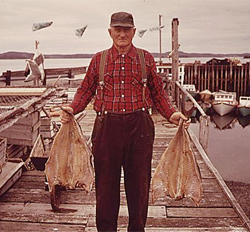The hundreds of billions of dollars the U.S. government has earmarked for infrastructure repair may not start truly flowing until 2010, but look around the high-end clothing boutiques and upscale department stores of America, and you can see we’re plenty ready for the challenges that lay ahead. Head to toe, from their Engineered Garments railroad conductor caps to their APC leather work boots, our hardest-dressing clotheshorses are tightening their hand-oiled Billy Kirk No. 109 skinny belts and preparing to rebuild America’s rusty bridges, its flimsy levees, its technologically obsolete sewer systems.
Of course, anyone who is willing and able to plunk down half a grand on work boots with meticulously top-stitched vamps — anyone, in fact, who knows what a top-stitched vamp is — isn’t likely to be messing up his manicure any time soon. Metaphorically, however, they’re punching the clock every morning, rain or shine, and working overtime to remind us that in a simpler, more authentic era, America was filled with lumberjacks, fishermen, steel workers, and other men who did more than just push pixels for a living.
Influenced by “heritage brands” like Pendleton, Woolrich, Filson, and various other brands whose original customers had very little interest in the finer points of vintage shuttle looms, workwear couture was pioneered in the 1990s by Japanese designers fanatically devoted to reverse-engineering the details of mid-century American apparel. But unlike most fashion trends, its relevance has only grown with the passage of time. Indeed, what better way for anxious knowledge workers to provision themselves against the specters of an economy built on speculation than with a plaid Alaskan guide shirt made from pristine deadstock wool, or a pair of Red Wing boots that exactly replicates the kind that Minnesota miners used to wear in 1953? Barricade your feet in muleskinner leather made from premium U.S. cattle hides and a couple pounds of rubber, and the shaky financial ground you’re standing on can’t help but feel a little firmer under foot.
And if you’re one of the savvy few who has done well in the downturn, well, even better: Never has it cost so much to look like you’re just coming home from the mill or the assembly line. Workwear couture lets you spend money as frivolously as you would if you were buying $300 fitted T-shirts from Dolce & Gabbana, but it feels a lot more prudent, responsible even. When you’re purchasing, say, a raw chambray miners shirt with tonal stitching and polished ox horn buttons sourced from New England’s oldest button-maker, you’re buying more than a shirt with an expertly tailored blue collar. You’re buying authenticity, history, craft, a garment built to last through gas explosions, floods and hurricanes, financial panics, and, yes, even the changing tides of fashion.
Plus, even in its most lavish incarnations, luxury workwear isn’t all that expensive. In the old indulgent days, before everyone started riding bicycles and shoehorning themselves into ugly little Priuses in deference to our sweaty friend the polar bear, economic elites bought Hummers and Escalades. Now that the dream is downsized, they buy Hummers for their feet and torsos — gorgeously over-built carpenter boots for $550, a burly tweed cameraman’s parka with enough pockets to house your entire collection of vintage iPods for $1,400. Hand-crafted by international artisans who display an enduring commitment to old-fashioned American quality, such exquisite articles of clothing can deliver all the visual wallop of a three-ton sport utility vehicle at a fraction of the price and with zero planet-choking emissions.
If it seems a little ironic that slender urban saplings are dressing like Paul Bunyan and the Marlboro Man, well, so what? In these increasingly polarized times, when one half of America thinks President Obama is the second coming of Adolf Hitler and the other half won’t be truly satisfied until we prosecute everyone from Dubya on down to Laura Bush for war crimes, it’s actually kind of nice to see bearded blue-state hipsters dressing like men who slaughter cattle and clear-cut forests for a living. Deep down in our heart of hearts, we may fantasize about the demise of whichever Other America we choose to align ourselves against. But every time some exclusive menswear retailer sells a quilted flannel shirt-jacket from Band of Outsiders to some vegan UI designer who’s refurbishing his Brooklyn loft to the strictest green building standards, it’s a tiny reminder that on the surface, where it really counts, we’re still more similar to each other than we often care to acknowledge. • 19 October 2009




